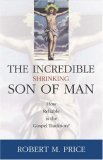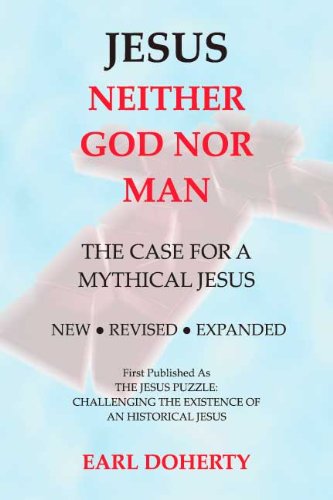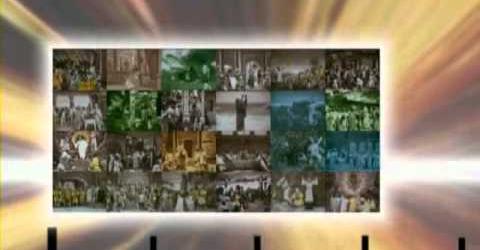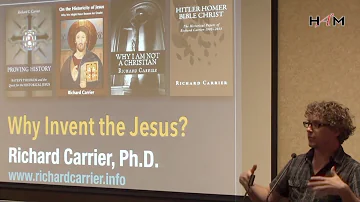Christian Faith Evolved from a MC to a HJ
After examination of everything the Epistles and the Gospels say about Jesus,
along with the religious and philosophical context of the time, this study gives its conclusion in a form of
probability assigned to each possible theory on Jesus.
- 90% chance Christianity began with a mythical Christ.
- 9% he was only a man who his followers claimed had resurrected.
- 1% that Jesus was God or a miraculous prophet (the highest I can go)
Then, after taking into account the scientific & philosophical arguments shown in Appendix: Non Historical Arguments,
this study decreased the probability of Christianity to zero.
So, here is the final result:
Who Was Jesus? |
||||||
| Theory | A Deified Man from Galilee | % Wold Population |
This Website Probabilities |
|||
| Man | Cruci- fixion |
Miracles | God & Savior |
|||
| Christian |  Famous Famous |
 |
 |
 |
Zero | |
| Supernatural |  Famous Famous |
 |
 |
 |
Negligible | |
| Secular |  Famous Famous |
 |
 |
 |
||
 Minor Minor |
 |
 |
 |
|||
| A Deity Historicized | ||||||
| Secular |  Minor Minor |
 |
 |
 |
0% | |
 |
 |
 |
 |
0% | 60% |
|
- This website supports the Myth theory developed initially by G.A Wells (although he owes a great deal to previous works) then E. Doherty and nowadays R. Carrier.
- The most popular secular theory today of the man deified gets only around 10%.
- The probability for non-secular hypothesis is negligible.
The Birth of Christianity Timeline
Estimated probaility: 90%
-
Before 20 CE - A Jewish apocalyptic sect

 A Jewish apocalyptic sect in the diaspora was preaching the end of the world and worshiping a deity called Christ/Messiah, revealed by God through the Scriptures.With Hellenic elements
A Jewish apocalyptic sect in the diaspora was preaching the end of the world and worshiping a deity called Christ/Messiah, revealed by God through the Scriptures.With Hellenic elements
 He was a celestial being, an intermediary between God and mankind, revealer, creator & sustainer of the universe and redeemer, like the Jewish Logos, another mysticism of the time.Paul was presumably persecuting them.
He was a celestial being, an intermediary between God and mankind, revealer, creator & sustainer of the universe and redeemer, like the Jewish Logos, another mysticism of the time.Paul was presumably persecuting them. -
20-40s CE - An Act of Salvation
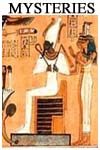 "A small fringe sect of Jews, probably led by a man called Cephas, came to believe this deity had undergone a salvific incarnation, death and resurrection in outer space, thus negating the cultic role of the Jerusalem temple... They also came to believe that through this act their salvation had been secured through the defeat of the demonic world order, so long as they shared in that sacrifice metaphysically through baptism and ritual communion, a concept already adopted by many similar cults of the time."R. Carrier On the Historicity of Jesus p.607
"A small fringe sect of Jews, probably led by a man called Cephas, came to believe this deity had undergone a salvific incarnation, death and resurrection in outer space, thus negating the cultic role of the Jerusalem temple... They also came to believe that through this act their salvation had been secured through the defeat of the demonic world order, so long as they shared in that sacrifice metaphysically through baptism and ritual communion, a concept already adopted by many similar cults of the time."R. Carrier On the Historicity of Jesus p.607 -
30-60s CE
 - Paul, Barnabas, Peter, Apollos... preaching a Mythical Christ:
After Paul got a vision of Jesus (by hallucination mushroom?), he spread this faith in the Lord, Christ, meeting on his way Cephas, James and John who didn't add anything to his message.The records testify of a sect already widespread from Rome to Alexandria.1 Thess., 1 Cori., 2. Cori, Galat., Romans, Phillip. & PhilemonQ?: An hypothetical List of sayings:
- Paul, Barnabas, Peter, Apollos... preaching a Mythical Christ:
After Paul got a vision of Jesus (by hallucination mushroom?), he spread this faith in the Lord, Christ, meeting on his way Cephas, James and John who didn't add anything to his message.The records testify of a sect already widespread from Rome to Alexandria.1 Thess., 1 Cori., 2. Cori, Galat., Romans, Phillip. & PhilemonQ?: An hypothetical List of sayings: Around the same time, a collection of sayings with little context could have been written near Galilee. Some of them could originate from a leader/founder of a counter-culture movement around 30 CE in Galilee. But there is no crucifixion, death and resurection and almost no stories including no miracles until the last layer.In this mythic paradigm, we estimate the probability that such a figure exists at around 1/3. However, whoever was this Q Jesus (if it was even his name), he has nothing in common with the Mythical Christ of Paul above, so unrelated to the birth of Christianity.
Around the same time, a collection of sayings with little context could have been written near Galilee. Some of them could originate from a leader/founder of a counter-culture movement around 30 CE in Galilee. But there is no crucifixion, death and resurection and almost no stories including no miracles until the last layer.In this mythic paradigm, we estimate the probability that such a figure exists at around 1/3. However, whoever was this Q Jesus (if it was even his name), he has nothing in common with the Mythical Christ of Paul above, so unrelated to the birth of Christianity. -
66-70 CE - The Jewish war destroyed the church in Jerusalem.
 After the war, most of the apostles of the generation of Paul would be dead, knowing their age and their risky life.
After the war, most of the apostles of the generation of Paul would be dead, knowing their age and their risky life. - 70-85 CE - Gospel of Mark
 Following Paul's visions, some attributed to this Christ a couple of new sayings, or shifted his nature towards a figure of the indefinite past. But the turning point happened when an unknown member of the sect created a story of this mythical character at a particular date and time on earth. The story of Jesus of Nazareth is mainly midrash and folklore and makes little sense without them.- Colossians, HebrewsOther canonical Epistles are written without mentionning any HJ.
Following Paul's visions, some attributed to this Christ a couple of new sayings, or shifted his nature towards a figure of the indefinite past. But the turning point happened when an unknown member of the sect created a story of this mythical character at a particular date and time on earth. The story of Jesus of Nazareth is mainly midrash and folklore and makes little sense without them.- Colossians, HebrewsOther canonical Epistles are written without mentionning any HJ. - 85-120 CE - Gospel of Matthew, Luke & JohnThey enlarged on the first man's tale. They borrowed much of what he had written, reworked it in their own particular ways and put in some additional material (Q).- James, 2 Thessalonians, Ephesians, 1 Peter, Revelation, 1, 2 & 3 John, JudeNew canonical Epistles are written without mentionning any HJ.Didache, 1 Clement, BarnabasOther Christian records are still lacking any HJ.
- 110 CE-300 CE - A Wide Diversity
1 & 2 Timothy, Titus, 2 PeterNew canonical Epistles are written without mentionning any HJ.Odes of Solomon, Hermas, Apoc. Peter, Secret James...Non canonical Christian records without mentionning any HJ.Ignatius, G. Thomas, Preach. Peter, Quadratus Athens, Aristides, PapiasChristian records mentionning a HJ.Christianity was extremely diverse with plenty of contradictory claims ... until the conversion of Constantine in 312 CE and the rise of Catholicism.
Credits
Most material is taken from Earl Doherty's books and website
Jesus Puzzle
Related Websites:
I highly recommend these books and documentary:
In 1971, with his first, sensational book, The Jesus of the Early Christians: A study in Christian origins,
G.A. Wells embarked on a single-handed enterprise to revive the old thesis of German scholarship "fiercely debated"
at the turn of the 20th century -- "Die Frage nach der Historizität Jesu", whether Jesus ever existed.
After WWII, with Kalthoff, Robertson, W.B. Smith, Drews dead, Couchoud retired,
Schweitzer in Gabon, the debate went into dormancy.
The personal genesis of Well's ideas
Wells's interest started with his year abroad in Switzerland in 1946 as a 20-year old student of German,
lodging with a Swiss Protestant pastor who was a pupil of Albert Schweitzer (still very much alive then, d. 1965).
Wells was introduced to Schweitzer's momentous
The Quest of the Historical Jesus - A Critical Study of its Progress from Reimarus to Wrede" (German:1906, English Tr.:1910),
leading him to reflect on the question of the historical evidence for Jesus, and the lack of it, in the early Christian documents.
It took Wells 20 years to complete his first book, and three years to find a publisher, Pemberton, a traumatic experience.
But the 3,000-run sold out quickly, and his second book, Did Jesus Exist? (1975) , was easily accepted.
Importance of German
Wells found German even more important than ancient Greek:
His expertise allowed him to read in the original the great German historical critics (mostly never translated into English):
a massive amount, on both sides of the debate, of the most comprehensive scholarship in the world
(stamped with the famous "Deutsche Gründlichkeit", "German thoroughness") --
giving him a marked advantage in promoting the non-historicity thesis to modern English readers.
He also gained exposure to the Dutch Radical School, through German translations
(and English ones in "Encyclopaedia Biblica", and Thomas Whittaker's book).
From an Amazon Review
Then E. Doherty started on this idea after he encountered a
serious presentation of the theory by Professor Wells.
Afterwards R. Carrier switched position from HJ to MJ after he read
the Jesus Puzzle by Doherty (like me).
This Website By Vincent Guilbaud
Who am I?
I am just an ordinary man with nothing to lose.
I was born in 1967 in a Catholic family in Angers, west of France.
Like my siblings, my experience with religion as a child or teenager was rather sweet
-there is no desire of taking any 'revenge' here.
I keep mostly good memories of that time, but starting the age of fourteen,
I was certainly more interested to understand the phenomena than to simply believe in it.
During my Engineering school in Paris, my faith decreased dangerously,
as it doesn't seem to be very compatible with science,
despite I was living the 2 first years in the seminary of St Sulpice!
Then, I still got married at church and attended several protestant masses in Rueil Malmaison,
driven more by curiosity.
It is only in 2002, after having moved to NC in the US, maybe partly because of 9/11/2001,
that I decided to study the Jesus question to find by myself
where I am on the subject. Well, I had no idea where I was putting my feet!
Knowledge makes you see the world differently!
I quit Christianity rapidly and became fascinated by this
incredible historical enigma of Jesus!
A puzzle where all pieces stick together the best in the Myth scenario developed since 1971 by
Wells, Doherty and Carrier.
I went on several discussion forums in France and the US to find how little the experts
know about the Myth theory and arguments and the lack of any Historical Jesus in so many Christian documents!
I also realized that too many people have too much vested interest for not being biased.
I read several books and regularly spend time on the web searching for whatever I can find on the subject.
Finally, I published my study in the form of this website.
It popularizes and summarizes the work of E. Doherty and others on the origin of christianity,
and shows that their theory is the best explanation for the records we have.
As we have seen in chapter 1 a Gap of Knowledge,
there is a vast ignorance on the result of secular scholarship,
and this website is also based on it.
Index
Scripture Index
Galatians
Summary
1. Where are we today?
2. A Critical Bug
Philippians
Summary
2. A Critical Bug
3. Epistles
1 Corinthians
1. Where are we today?
3. Epistles
2 Corinthians
1 Thessalonians
Romans
2. A Critical Bug
Ephesians
Colossians
Hebrews
James
2. A Critical Bug
1 Peter
1 Timothy
2. A Critical Bug
2 Timothy
3. Epistles
Titus
1 John
2 John
3. Epistles
Jude
3. Epistles
Revelation
Mark
2. A Critical Bug
No Parable Mk 4, Mt 13, Lk 8
Matthew
2. A Critical Bug
Luke
John
3. Epistles
Acts
Old Testament
1. Where are we today?
To Do: Chap 4. Gospels, chap 5. Outside the Bible, chap 6. Debatting
Open Popup menu to navigate other pages


